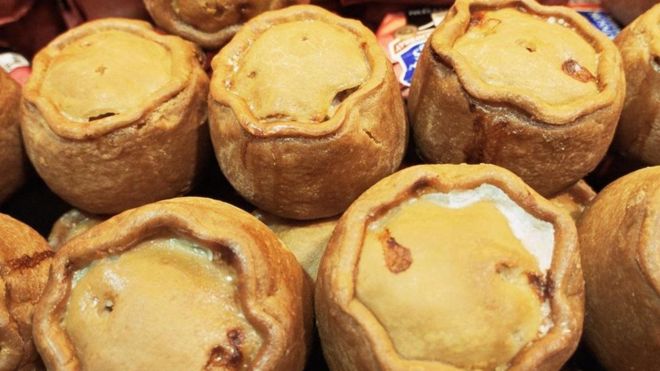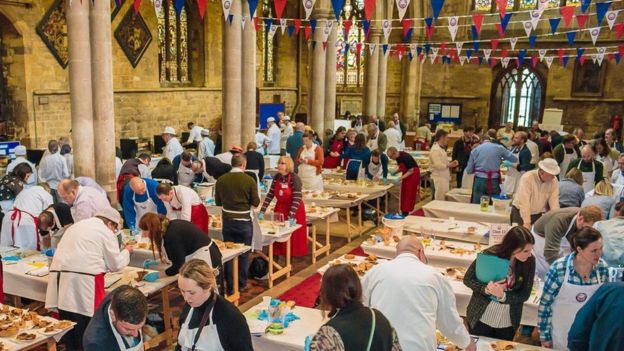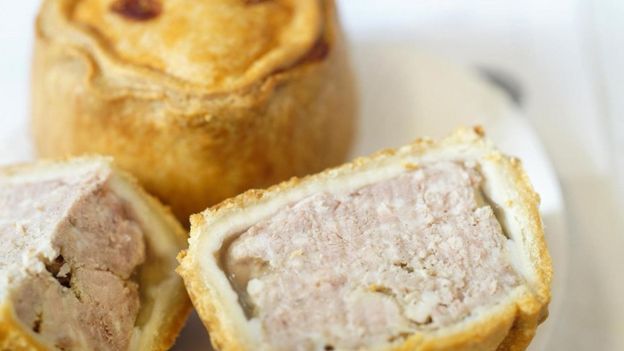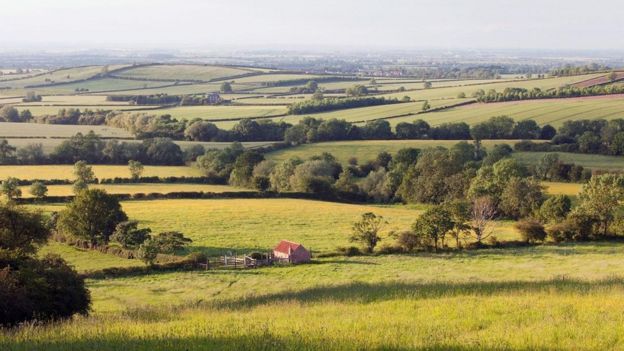從天而降 改變了英語的英國餡餅
 ALAMY
ALAMY
每年三月,萊斯特郡(Leicestershire)梅爾頓莫布雷鎮(Melton Mowbray)的聖瑪麗教堂(St Mary's)都會成為餡餅的聖地,裏面擺滿桌子,上面擺放著800多種點心。
一些品種特別離奇。雖然今年的"特殊肉類"(Speciality Meat)中最詭異的一種是蟋蟀派(cricket pie),但是往年的優勝者中知名的一個是2014年菲爾·沃姆斯利(Phil Warmsley)的松鼠派。沃姆斯利告訴我,這種派起源於中世紀,但仍然會在馬基特哈伯勒(Market Harborough)兩周一次的農貿市場銷售一空。 "它們也是處置有害生物的好辦法",他笑道。
 ALAMY
ALAMY
不僅僅是松鼠派:幾百年前,許多種類的餡餅就已經是英國美食中深受喜愛的部分。十一世紀有記載顯示,東安格利亞(East Anglia)以鯡魚派向國王繳納賦稅——這種做法持續了800多年,各城鎮都要求繳納 "由100隻鯡魚烤制的24個酥皮餡餅"作為每年的貢物。
1429年亨利六世(Henry VI )加冕儀式的記載中提到一個稱為"孔雀餡餅"(Partryche and Pecock)豪華餡餅,而1465年為慶祝新的約克大主教(Archbishop of York)就任舉行的盛宴則讓客人們飽餐了5500隻鹿肉餡餅。英國歷史上偉大的藝術家威廉·荷加斯(William Hogarth)在他1750年的畫作《向芬奇利的進軍》(The March to Finchley)中,將一位街頭餡餅攤販置於畫面中央。
即使在早期,對富人和窮人而言餡餅也有不同的用途:對前者而言是用以炫耀的美味佳餚,對後者則是便於攜帶的食物。所以雖然富人的宴席可能囊括了從獵禽到貽貝等各式各樣的餡料,不太富裕的人卻把簡易的餡餅作為一種在戶外勞作或旅行時果腹的方式——餡餅的外皮使之既方便攜帶又保留了餡料的美味。
以貝德福德郡瘦長形羊酥餃(Bedfordshire Clanger)為例,它是一種將主菜和甜點巧妙結合在一起的經典英國菜,一端填充可口開胃的餡料如豬肉,而另一端則佐以像梨子這樣的甜品。 這個名字來自當地的一個俚語,"clang",意思是狼吞虎咽。 然而,將兩種餡料填充進同一隻派會使其笨重而不易操作, 而且太容易掉下來,於是就演繹出了表達粗心大意而犯錯的英語短語"dropping a clanger"(意思是"當眾失言")。
幾個世紀以來,派一直為英語增添豐富的韻味。 即使是莎士比亞(Shakespeare),也在他1613年的劇目《亨利八世》中寫道:"沒有任何人的派能逃離他野心勃勃的手指"("No man's pie is freed from his ambitious finger"),於是就給英文引進了一個短語"a finger in every pie" ("在每個派裏都粘一指頭")。(意思是參與了很多不需要參與的事情)
 BRITISH PIE AWARDS
BRITISH PIE AWARDS
同時,醉酒狀態被形容為"pie-eyed"("派眼大睜"),很可能是由某個過度飲酒的人那裏引申而來,這人眼睛大張而空洞,好像餡餅頂部的開口一樣。短語"As easy as pie" ("像餡餅一樣簡單",意思是極容易),它首次在1886年的賽馬報《體育生涯》(Sporting Life)中被記載為"like eating pie"("就像吃餡餅"),源自餡餅作為方便食物的歷史角色。
與此同時,"Eating humble pie"("食用謙卑的餡餅")來自中世紀的獵鹿活動,當時獵來的肉是以社會地位尊卑來進行分配的。最好的鹿肉分給權貴,而下等人只能得到"nombles",這是諾曼法語(Norman French)中表示鹿內臟的詞匯。 "內臟"派英語化後成為"謙卑的"派。
 ALAMY
ALAMY
除了改變英語,餡餅本身也已成為文化財富。
2008年,歐盟授予梅爾頓莫布雷豬肉派"地理標誌保護"(PGI)——與香檳具有同樣的卓著地位。 梅爾頓卡內基博物館(Melton Carnegie Museum)解釋了這個來自諾曼人集市小鎮的餡餅是怎樣發展到具有如此聲望:特別是當地的豬狂熱喜愛當地同樣知名的斯蒂爾頓奶酪(Stilton cheese)製作之餘的乳清,導致當地許多農民飼養並食用這種牲畜。 其結果是將切碎的豬肉放入餡餅中烹熟後再冷食。這些成為了17世紀以來廣受該地區大型獵狐兄弟會以及當地農場工人歡迎的馬背餐。
 ALAMY
ALAMY
在約克郡的丹比戴爾(Denby Dale)可以發現另一項傳統帶來的財富,這裏是巨型餡餅的世界之都。該村1788年為紀念喬治三世(George III)從一場瘋癲發作中清醒過來而烤制了它的第一個巨型餡餅,儘管遺憾的是關於其大小或佐料成分沒有書面記錄。此後,該村烤制了九個"巨型派"。 1815年,為慶祝打敗拿破侖(Napoleon)烤制了"勝利派"(Victory Pie),共用了兩隻羊和20隻家禽;而2000年的"千禧派"(Millennium Pie)則長達12米,重10噸。
派為英國精英們提供的炫耀方式不僅僅是尺寸。 16世紀和17世紀,所謂的"驚喜派"(Surprised Pyes)風靡一時,烤成後額外添加的可拆卸的酥皮蓋子下面掩藏意想不到的東西,這樣的派給貴族宴會上的賓客留下了深刻印象。
16世紀製作的一個巨型皇家派裏隱藏著一隊音樂家,他們在切餡餅的時候開始演奏,另一個伎倆就是有人衝破餅皮開始吟誦詩歌。把活著的鳥藏在派裏也很受歡迎——因此就有了童謠《唱一首六便士之歌》(Sing a Song of Sixpence)中的"二十四隻烏鶇"('four and twenty blackbirds')。
在大獎賽中"區域派類"(Regional Pie)表明餡餅不僅僅標明一個人的社會地位,也標誌了英國不同地區的食物。今年的冠軍是諾福克犁布丁(Norfolk Plough Pudding),它是用香腸肉,培根,鼠尾草,洋葱和黃糖製成的。這種餡餅在東安格利亞那帶是傳統食物,在主顯節(Epiphany)之後的第一個星期一,當春天耕種就要開始時烤制。
 ALAMY
ALAMY
但康沃爾郡(Cornwall)引人注目的仰望星空派(Stargazy Pie)可能是最與眾不同的。這種餡餅用沙丁魚烹制,魚從派的外皮向外抬頭凝望著,這種獨特的餡餅,起源於一個17世紀毛斯合爾(Mousehole)漁村的故事。故事講述一位名叫湯姆·鮑科克(Tom Bawcock)的漁夫勇敢地冒著十二月的風暴,捕獲了一大拖網的魚拯救了饑餓的村莊。為了慶祝,他的收獲被烘烤成一個巨大的慶祝派 ——留下的魚頭伸出派,表明魚荒已經結束了。今天,仰望星空派用七種魚,煮土豆,煮雞蛋和白汁沙司的傳統方式烤制。魚不僅僅具有象徵性,還有實際的目的:魚頭的油脂讓糕餅口味豐富也滋潤了餅皮。
如果這聽起來有點古怪又有趣,那你就沒弄錯。而在二十一世紀,這可能是延續餡餅傳統的最好理由之一。正如凱文·阿什比牧師(Reverend Kevin Ashby)在傳統的英國派大獎賽(British Pie Awards)為餡餅祝福之後說:"我們必須有派。在派的面前壓力並不存在!"
請訪問 BBC Travel 閲讀 英文原文。
Tiny pies have been a favourite food in Britain since the Middle Ages – and have changed the English language with idioms, nursery rhyme verses, even a mention by Shakespeare.
Every March, St Mary’s church in the Leicestershire town of Melton Mowbray becomes a cathedral of pies: it fills with tables bearing more than 800 pastries.
Some recipes are particularly offbeat. While the quirkiest entry in this year's Speciality Meat category was a cricket pie, one celebrated past winner was Phil Walmsley's squirrel pie in 2014. Walmsley told me that it has medieval origins, but still sells out at Market Harborough’s twice-monthly farmers’ market. “They're also a great way to deal with a pest,” he laughs.
It’s not just the squirrel pie: several hundred years ago, there were many types of pies already a beloved part of British cuisine. Records from the 11th Century show East Anglia paying levies to the Crown with herring pies – a practice that continued for 800 years – with towns required to send an annual tribute of “100 herrings baked in 24 pasties”.
Records of Henry VI’s 1429 coronation speak of a suitably regal pie of ‘Partryche and Pecock’, while the 1465 feast for the new Archbishop of York saw guests scoff 5,500 venison pasties. The great artistic chronicler of English life, William Hogarth, puts a street pie seller centre-stage in his 1750 painting The March to Finchley.
Even in their early days, pies served different purposes for the rich and poor: as show-off delicacies for the former and portable food for the latter. So while wealthy feasts might include pies containing anything from game birds to mussels, the less well-off used simpler pies as a way to have food while doing outdoor work or travelling – the crust both carried and preserved the tasty filling.
Take, for example, the Bedfordshire Clanger: a British classic which cleverly combines main course and dessert, with savoury ingredients like pork at one end and sweet ingredients like pear at the other. The name comes from a local slang word, ‘clang’, which means to eat voraciously. However, cramming two courses into a pie makes a clanger rather unwieldy – and all too easy to drop, inspiring the English phrase 'dropping a clanger' for a careless mistake.
Pies have been adding rich flavour to the English language for centuries. Even Shakespeare got in on the act, writing in his 1613 play Henry VIII that “No man’s pie is freed from his ambitious finger”, giving English the phrase 'a finger in every pie'.
Meanwhile, the description of a drunken state as ‘pie-eyed’ likely takes its cue from someone who, thanks to having over-imbibed, has eyes as wide and blank as the top of a pie. ‘As easy as pie’ – first recorded as 'like eating pie' in the horse-racing newspaper Sporting Life in 1886 – springs from pies’ historical role as convenience food.
‘Eating humble pie’, meanwhile, comes from medieval deer hunting, when meat from a successful hunt was shared out on the basis of social status. While the finest cuts of venison went to the rich and powerful, the lower orders made do with the ‘nombles’: a Norman French word for deer offal. Anglicisation saw ‘nombles’ pie become ‘humble’ pie.
As well as changing the English language, pies have become a cultural treasure in their own right.
In 2008, the European Union gave Melton Mowbray's pork pies ‘protected geographical indication’ (PGI) – the same elite status as Champagne. The Melton Carnegie Museum explains how the pies from this Norman market town developed such fame: pigs in particular had a taste for the whey left over from making the equally-renowned local Stilton cheese, leading to many local farmers keeping – and eating – the animals. This resulted in the chopped pork which was put into the pie, cooked and then eaten cold. These became popular horseback meals for the area’s large fox-hunting fraternity from the 17th Century onwards, as well as for local farm workers.
Another treasure of a tradition can be found in Yorkshire's Denby Dale, which is the world capital of giant pies. The village baked its first mammoth creation in 1788 to mark George III's recovery from a bout of madness, though sadly there is no written record of its size or ingredients. Since then, nine ‘megapies’ have been created. The 1815 Victory Pie celebrated the defeat of Napoleon with a pie containing two sheep and 20 fowls, while the Millennium Pie of 2000 was 12m long and weighed 10 tonnes.
Pies have provided a way for the British elite to show off with more than just size. The 16th and 17th Centuries saw the rise of so-called Surprised Pyes, created to impress guests at aristocratic banquets by concealing unexpected things under an additional removable pastry lid added after cooking.
One gigantic 16th-Century royal pie concealed a gaggle of musicians who began playing when the pie was cut, while another trick saw people burst out of a pie to recite poetry. Concealing live birds was also popular – hence the ‘four and twenty blackbirds’ in the nursery rhyme Sing a Song of Sixpence.
The Regional Pie category at the Awards acknowledges how pies are edible markers of not only one’s social status, but of different British regions. This year's winner was a Norfolk Plough Pudding, made with sausage meat, bacon, sage, onion and brown sugar. It’s traditionally baked in that part of East Anglia for the first Monday after Epiphany, when spring ploughing is meant to begin.
But it was Cornwall’s eye-catching Stargazy Pie that might be the most distinctive. Cooked with sardines gazing up from the crust, this distinctive pie has roots in a 17th-Century tale from the fishing village of Mousehole. The story goes that a fisherman named Tom Bawcock braved December storms to land a huge haul of fish that saved the village from starvation. To celebrate, his catch was baked into a giant celebratory pie – with fish heads left poking out as proof that the fish famine was over. Today, Stargazy Pie is traditionally baked with seven kinds of fish, boiled potatoes, boiled eggs and white sauce. The fish serve a practical purpose, not just a symbolic one: oil from the heads enriches the pastry and moistens the pie.
If that sounds somewhat quirky and fun, you’re not mistaken. And in the 21st Century, that may be one of the best reasons to continue the pie tradition. As Reverend Kevin Ashby puts it after his blessing of the pies, a tradition of the British Pie Awards: “We must have pies. Stress can’t exist in the presence of a pie!”





沒有留言:
張貼留言